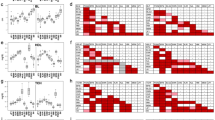Abstract
The Diversity Outbred (DO) population is a heterogeneous stock derived from the same eight founder strains as the Collaborative Cross (CC) inbred strains. Genetically heterogeneous DO mice display a broad range of phenotypes. Natural levels of heterozygosity provide genetic buffering and, as a result, DO mice are robust and breed well. Genetic mapping analysis in the DO presents new challenges and opportunities. Specialized algorithms are required to reconstruct haplotypes from high-density SNP array data. The eight founder haplotypes can be combined into 36 possible diplotypes, which must be accommodated in QTL mapping analysis. Population structure of the DO must be taken into account here. Estimated allele effects of eight founder haplotypes provide information that is not available in two-parent crosses and can dramatically reduce the number of candidate loci. Allele effects can also distinguish chance colocation of QTL from pleiotropy, which provides a basis for establishing causality in expression QTL studies. We recommended sample sizes of 200–800 mice for QTL mapping studies, larger than for traditional crosses. The CC inbred strains provide a resource for independent validation of DO mapping results. Genetic heterogeneity of the DO can provide a powerful advantage in our ability to generalize conclusions to other genetically diverse populations. Genetic diversity can also help to avoid the pitfall of identifying an idiosyncratic reaction that occurs only in a limited genetic context. Informatics tools and data resources associated with the CC, the DO, and their founder strains are developing rapidly. We anticipate a flood of new results to follow as our community begins to adopt and utilize these new genetic resource populations.



Similar content being viewed by others
References
Cheng R, Lim JE, Samocha KE, Sokoloff G, Abney M, Skol AD, Palmer AA (2010) Genome-wide association studies and the problem of relatedness among advanced intercross lines and other highly recombinant populations. Genetics 185(3):1033–1044
Chesler EJ, Miller DR, Branstetter LR, Galloway LD, Jackson BL, Philip VM, Voy BH, Culiat CT, Threadgill DW, Williams RW, Churchill GA, Johnson DK, Manly KF (2008) The Collaborative Cross at Oak Ridge National Laboratory: developing a powerful resource for systems genetics. Mamm Genome 19(6):382–389
Collaborative Cross Consortium (2012) The genome architecture of the Collaborative Cross mouse genetic reference population. Genetics 190(2):389–401
Iancu OD, Darakjian P, Walter NA, Malmanger B, Oberbeck D, Belknap J, McWeeney S, Hitzemann R (2010) Genetic diversity and striatal gene networks: focus on the Heterogeneous Stock-Collaborative Cross (HS-CC) mouse. BMC Genomics 11:585
Keane TM, Goodstadt L, Danecek P, White MA, Wong K, Yalcin B, Heger A, Agam A, Slater G, Goodson M, Furlotte NA, Eskin E, Nellåker C, Whitley H, Cleak J, Janowitz D, Hernandez-Pliego P, Edwards A, Belgard TG, Oliver PL, McIntyre RE, Bhomra A, Nicod J, Gan X, Yuan W, van der Weyden L, Steward CA, Bala S, Stalker J, Mott R, Durbin R, Jackson IJ, Czechanski A, Guerra-Assunção JA, Donahue LR, Reinholdt LG, Payseur BA, Ponting CP, Birney E, Flint J, Adams DJ (2011) Mouse genomic variation and its effect on phenotypes and gene regulation. Nature 477(7364):289–294
Machleder D, Ivandic B, Welch C, Castellani L, Reue K, Lusis AJ (1997) Complex genetic control of HDL levels in mice in response to an atherogenic diet. Coordinate regulation of HDL levels and bile acid metabolism. J Clin Invest 99(6):1406–1419
Petkov PM, Graber JH, Churchill GA, DiPetrillo K, King BL, Paigen K (2005) Evidence of a large-scale functional organization of mammalian chromosomes. PLoS Genet 1(3):e33
Rockman MV, Kruglyak L (2008) Breeding designs for recombinant inbred advanced intercross lines. Genetics 179(2):1069–1078
Svenson KL, Von Smith R, Magnani PA, Suetin HR, Paigen B, Naggert JK, Li R, Churchill GA, Peters LL (2007) Multiple trait measurements in 43 inbred mouse strains capture the phenotypic diversity characteristic of human populations. J Appl Physiol 102(6):2369–2378
Svenson KL, Gatti DM, Valdar W, Welsh CE, Cheng R, Chesler EJ, Palmer AA, McMillan L, Churchill GA (2012) High-resolution genetic mapping using the Mouse Diversity Outbred population. Genetics 190(2):437–447
Van Belle G (2002) Statistical rules of thumb, Chap 2. Wiley, New York
Wang JR, Pardo-Manuel de Villena F, Lawson HA, Cheverud JM, Churchill GA, McMillan L (2012) Imputation of single-nucleotide polymorphisms in inbred mice using local phylogeny. Genetics 190(2):449–458
Wittenburg H, Lyons MA, Li R, Kurtz U, Wang X, Mossner J, Churchill GA, Carey MC, Paigen B (2006) QTL mapping for genetic determinants of lipoprotein cholesterol levels in combined crosses of inbred mouse strains. J Lipid Res 47(8):1780–1790
Yang H, Bell TA, Churchill GA, Pardo-Manuel de Villena F (2007) On the subspecific origin of the laboratory mouse. Nat Genet 39(9):1100–1107
Yang H, Wang JR, Didion JP, Buus RJ, Bell TA, Welsh CE, Bonhomme F, Yu AH, Nachman MW, Pialek J, Tucker P, Boursot P, McMillan L, Churchill GA, Pardo-Manuel de Villena F (2011) Subspecific origin and haplotype diversity in the laboratory mouse. Nat Genet 43(7):648–655
Acknowledgments
Development and maintenance of the DO has benefitted from the effort and expertise of Lisa Somes, Marge Strobel, Elissa Chesler, and Darla Miller and was supported with funding provided by The Jackson Laboratory. Riyan Cheng, Abraham Palmer, and William Valdar contributed to the development of analytical methods described here. Fernando Pardo-Manuel de Villena, Leonard McMillan, and Catherine Welsh at the University of North Carolina at Chapel Hill developed the MUGA array and associated software. Additional support was provided by NIH grants GM076468 and GM070683.
Author information
Authors and Affiliations
Corresponding author
Rights and permissions
About this article
Cite this article
Churchill, G.A., Gatti, D.M., Munger, S.C. et al. The diversity outbred mouse population. Mamm Genome 23, 713–718 (2012). https://doi.org/10.1007/s00335-012-9414-2
Received:
Accepted:
Published:
Issue Date:
DOI: https://doi.org/10.1007/s00335-012-9414-2




